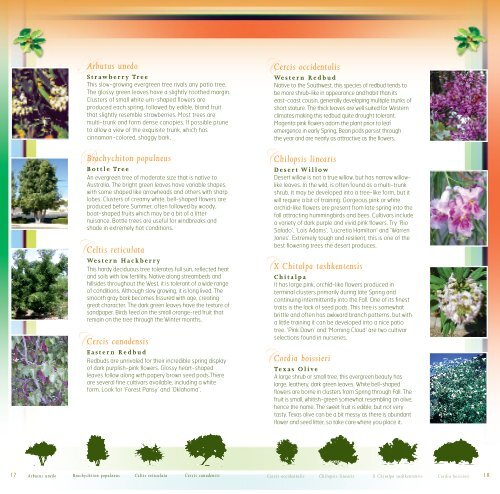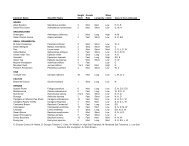trees for Tomorrow.pdf - Nevada Division of Forestry
trees for Tomorrow.pdf - Nevada Division of Forestry
trees for Tomorrow.pdf - Nevada Division of Forestry
You also want an ePaper? Increase the reach of your titles
YUMPU automatically turns print PDFs into web optimized ePapers that Google loves.
17<br />
B<br />
C<br />
C<br />
Arbutus unedo<br />
Strawberry Tree<br />
This slow-growing evergreen tree rivals any patio tree.<br />
The glossy green leaves have a slightly toothed margin.<br />
Clusters <strong>of</strong> small white urn-shaped flowers are<br />
produced each spring, followed by edible, bland fruit<br />
that slightly resemble strawberries. Most <strong>trees</strong> are<br />
multi-trunk and <strong>for</strong>m dense canopies. If possible prune<br />
to allow a view <strong>of</strong> the exquisite trunk, which has<br />
cinnamon-colored, shaggy bark.<br />
Brachychiton populneus<br />
Bottle Tree<br />
An evergreen tree <strong>of</strong> moderate size that is native to<br />
Australia. The bright green leaves have variable shapes,<br />
with some shaped like arrowheads and others with sharp<br />
lobes. Clusters <strong>of</strong> creamy white, bell-shaped flowers are<br />
produced be<strong>for</strong>e Summer, <strong>of</strong>ten followed by woody,<br />
boat-shaped fruits which may be a bit <strong>of</strong> a litter<br />
nuisance. Bottle <strong>trees</strong> are useful <strong>for</strong> windbreaks and<br />
shade in extremely hot conditions.<br />
Celtis reticulata<br />
Western Hackberry<br />
This hardy deciduous tree tolerates full sun, reflected heat<br />
and soils with low fertility. Native along streambeds and<br />
hillsides throughout the West, it is tolerant <strong>of</strong> a wide range<br />
<strong>of</strong> conditions. Although slow growing, it is long lived. The<br />
smooth gray bark becomes fissured with age, creating<br />
great character. The dark green leaves have the texture <strong>of</strong><br />
sandpaper. Birds feed on the small orange-red fruit that<br />
remain on the tree through the Winter months.<br />
Cercis canadensis<br />
Eastern Redbud<br />
Redbuds are unrivaled <strong>for</strong> their incredible spring display<br />
<strong>of</strong> dark purplish-pink flowers. Glossy heart-shaped<br />
leaves follow along with papery brown seed pods.There<br />
are several fine cultivars available, including a white<br />
<strong>for</strong>m. Look <strong>for</strong> ‘Forest Pansy’ and ‘Oklahoma’.<br />
Arbutus unedo Brachychiton populneus Celtis reticulata<br />
C<br />
C<br />
C<br />
C<br />
Cercis occidentalis<br />
Western Redbud<br />
Native to the Southwest, this species <strong>of</strong> redbud tends to<br />
be more shrub-like in appearance and habit than its<br />
east-coast cousin, generally developing multiple trunks <strong>of</strong><br />
short stature. The thick leaves are well suited <strong>for</strong> Western<br />
climates making this redbud quite drought tolerant.<br />
Magenta pink flowers adorn the plant prior to leaf<br />
emergence in early Spring. Bean pods persist through<br />
the year and are nearly as attractive as the flowers.<br />
Chilopsis linearis<br />
Desert Willow<br />
Desert willow is not a true willow, but has narrow willowlike<br />
leaves. In the wild, is <strong>of</strong>ten found as a multi-trunk<br />
shrub. It may be developed into a tree-like <strong>for</strong>m, but it<br />
will require a bit <strong>of</strong> training. Gorgeous pink or white<br />
orchid-like flowers are present from late spring into the<br />
fall attracting hummingbirds and bees. Cultivars include<br />
a variety <strong>of</strong> dark purple and vivid pink flowers. Try ‘Rio<br />
Salado’, ‘Lois Adams’, ‘Lucretia Hamilton’ and ‘Warren<br />
Jones’. Extremely tough and resilient, this is one <strong>of</strong> the<br />
best flowering <strong>trees</strong> the desert produces.<br />
X Chitalpa tashkentensis<br />
Chitalpa<br />
It has large pink, orchid-like flowers produced in<br />
terminal clusters primarily during late Spring and<br />
continuing intermittently into the Fall. One <strong>of</strong> its finest<br />
traits is the lack <strong>of</strong> seed pods. This tree is somewhat<br />
brittle and <strong>of</strong>ten has awkward branch patterns, but with<br />
a little training it can be developed into a nice patio<br />
tree. ‘Pink Dawn’ and ‘Morning Cloud’ are two cultivar<br />
selections found in nurseries.<br />
Cordia boissieri<br />
Texas Olive<br />
A large shrub or small tree, this evergreen beauty has<br />
large, leathery, dark green leaves. White bell-shaped<br />
flowers are borne in clusters from Spring through Fall. The<br />
fruit is small, whitish-green somewhat resembling an olive,<br />
hence the name. The sweet fruit is edible, but not very<br />
tasty. Texas olive can be a bit messy as there is abundant<br />
flower and seed litter, so take care where you place it.<br />
Cercis canadensis Cercis occidentalis Chilopsis linearis X Chitalpa tashkentensis Cordia boissieri<br />
18



